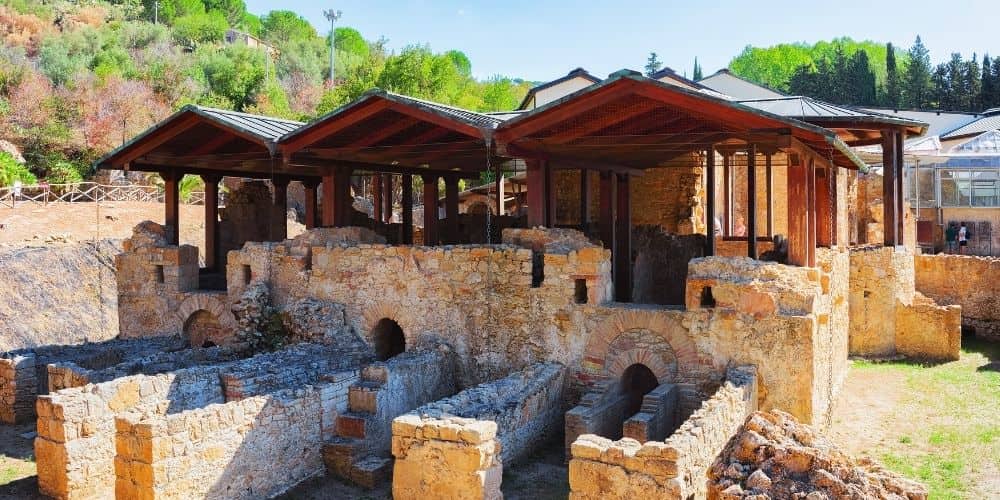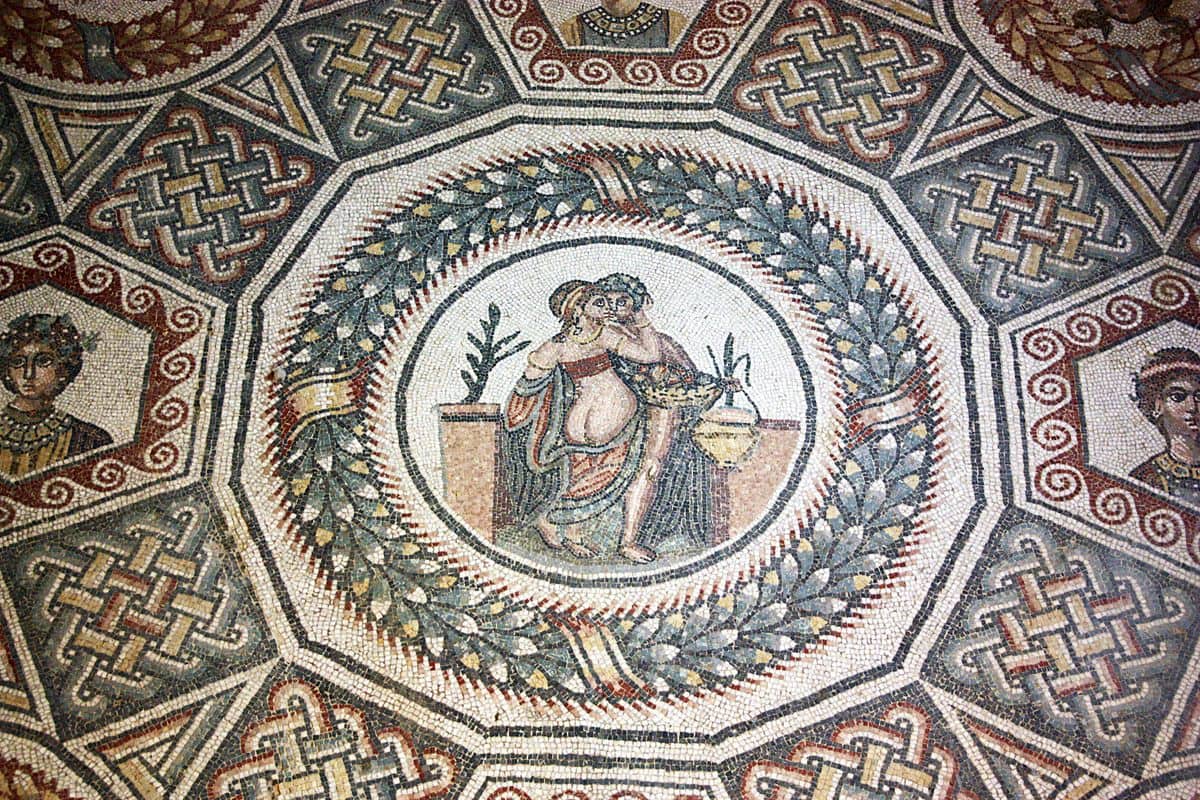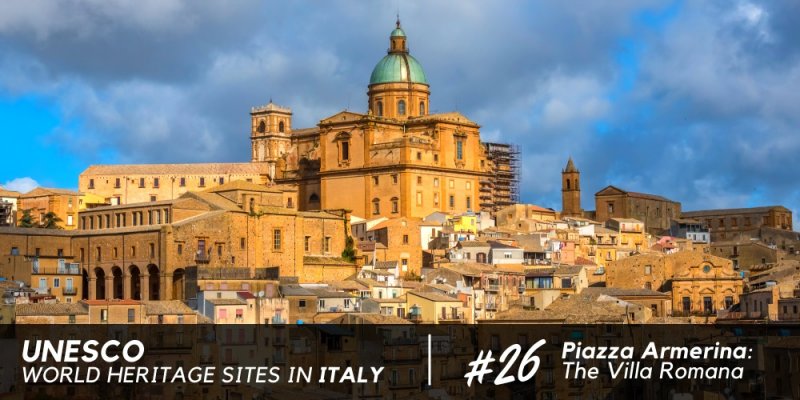"The Villa Romana del Casale in Piazza Armerina is a sublime example of a luxurious Roman villa, which represents the prevalence of the social and economic structures of its time. The mosaics decorating it are exceptional for their artistic quality and for the innovation of their purpose”.

Place and History

In Piazza Armerina (Enna) there is the most important example of a luxury Roman villa of the late imperial period, a large estate around which the typical activities of the rural economy of the Western Empire took place. In addition to the layout of the architectural structure, the Villa is worthy of attention for the floor mosaics that decorate almost every room; these are the best mosaics in situ anywhere in the Roman world.
Previously, on the site where the late Roman villa was built, there was a rural settlement, a farm, although the evidence is scarce. Its orientation was the same as that of the baths in the house, and its foundations were discovered underneath the villa. The villa presents a functional organization of spaces typical of late antique Roman architecture, characterized by the arrangement of structures according to the orographic orientation of the land, which determined the fan-shaped positioning of the different building complexes and their terraced arrangement. The structure, originally composed of forty-eight rooms (including courtyards, galleries, baths, residential and service rooms, the baths, and the basilica) in 3500 square meters, consists of four different building complexes.
The monumental entrance (from the first room it is possible to guess the social rank of the owner, who probably had direct contacts with the imperial court) led into a polygonal vestibule; from here one accessed the gymnasium and the complex system of the baths, consisting of the octagonal frigidarium (cold room), the tepidarium (warm room) and three calidaria (hot baths). In the central body of the Villa, consisting of the imposing quadrangular peristyle, there is a first part of the famous mosaic floor depicting a series of laurel wreaths with heads of animals belonging to different species; inside there is a garden with a large pool and different rooms, arranged on the long sides of the courtyard (kitchens, bedrooms, and a small apsidal sanctuary). To the southwest of the latter is the third complex of the villa, articulated around a peristyle on elliptical pillars and, at the back, a large square hall with three apses (trichora), with mosaics depicting classical mythology, in particular the stories of Hercules. The fourth complex is located to the east of the main peristyle and is connected by a long corridor containing the well-known figurative cycle known as the 'Great Hunt', one of the most famous and rightly admired and studied floor mosaics, depicting the capture of various animals, using different techniques of the time. This group also includes the basilica, a large reception hall that has retained its original marble floor almost unchanged. Most of the small rooms in this part of the complex have floor mosaics depicting playful and domestic activities. Admiring the residential rooms, the luxury and attention to decoration increase in proportion to the rooms' importance and uses, while the part destined for services is characterized by rustic or less often mosaic floors, with wall paintings containing small figures.
The Villa continued to be inhabited in the Byzantine and Early Medieval period (5th-7th centuries) and the Arab-Norman period (10th-12th centuries), then it was used as an emporium and agricultural center. Between the 14th and 15th centuries, after the devastation of the previous centuries, was established a new agricultural center called the Casale. After damage, floods, and landslides that affected the area, the ancient Roman settlement was abandoned, but it is thanks to this very covering that, over time, the Villa's exceptional mosaic apparatus has been preserved to this day.
The Criteria

The Mosaics Series

The mosaic treasure of the Villa Romana del Casale shows the living habits of the Roman ruling class and shows the mutual influences between cultures and exchanges in the ancient Mediterranean area (the Roman world and the North African area). They are distributed among the chambers of the nobility and each one tells a family or socio-cultural tradition of that historical period.
Animal heads encircled by acanthus leaves (such as a lion) decorate the arch over the triclinium with three apses.Ulysses offers wine to the Cyclops Polyphemus in an antechamber to the north.The chariot race precedes the entrance to the baths.The theme of hunting is very frequent in several rooms (e.g. there is a scene of a boar hunt).Young girls playing ball in a bikini-like outfit.Lovers embraced, probably Cupid and Psyche, in the private rooms for spouses in the north.A child ties a duck by the neck in one of the cubicula.A chariot race pulled by birds in the other cubiculum.Cupid fishing in the cubicula overlooking the oval peristyle.A procession of nereids, tritons, and a wide variety of marine animals winds its way through the apsidal hall, which is entered through a large semicircular portico.The twelve labors of Hercules are the motif that decorates the luxurious triclinium where the rich owner of the villa, organized sumptuous banquets (it could be Lucius Aradio Valerius Proculus Populonius, governor of Sicily between 327 and 331 AD).About the author
Written on 06/07/2021



Eleonora Monaco
The Villa Romana del Casale in Piazza Armerina (Enna), now part of the Archaeological Park of the Villa Romana del Casale and the Archaeological Areas of Piazza Armerina and the neighboring municipalities, is one of the finest and best-preserved examples of a luxury Roman villa from the late imperial period, together with its exceptional and unique mosaics.